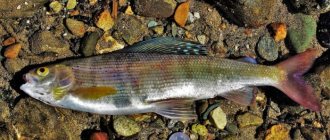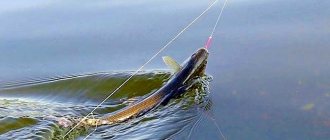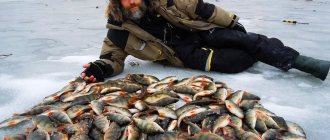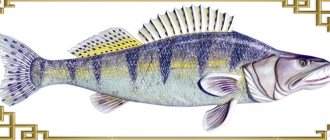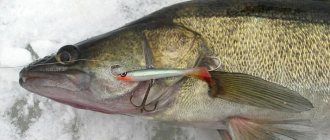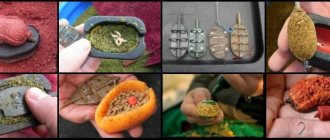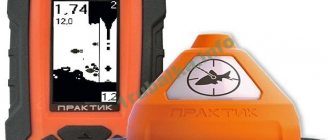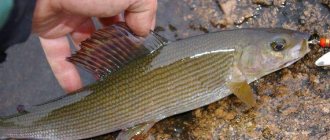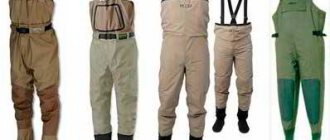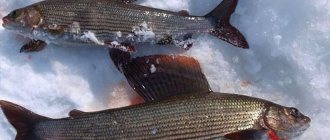The Tyrolean stick (aka Tyrolean) is an unusual “floating” weight and a method of spinning equipment of the same name. Tyrolean is used for catching predatory and semi-predatory fish using wobblers, spoons, and jig baits.
The Tyrolean stick is also used for fishing with streamers, silicone imitations of aquatic insects and flies for grayling, trout, minnow, chub, ide, bream and other fish - as an alternative to fly fishing.
Let the “world fishermen” who also use such equipment for peaceful fish with live bait - a worm, maggot, grasshopper - not spit on us. But today we will concentrate on catching predatory fish.
It was for catching trout and grayling on fast mountain rivers that this rig was used for the first time, in the city of the same name in Tyrol.
Stock Tyrolean sticks of different weights and sizes
Tyrolka, or a lifesaver for fishing
A Tyrolean stick type setup in its classic form is a non-snacking weight made in the form of a flexible hollow polymer tube with a diameter of 5 to 12 mm (rarely more) with a hermetically inserted weight at one end and a sealed plastic plug with a fastening ring/swivel at the other.
The setting is the working part of the equipment, similar to the Tyrolean stick.
This type of weights does not have clear parameters; there is a wide variety of weights, which differ in size, weight, shape, and types of loading.
Ideally, it is assumed that the air chamber formed inside the cylinder will provide positive buoyancy and will keep the load at the bottom in a vertical position. But in practice this is not always the case. Due to the fact that this factor is influenced by many factors - the quality of workmanship, the selected bait, the strength of the current, the depth of fishing, the inept actions of the fisherman.
It is clear that such a vertical position of the weight gives the angler two main bonuses. Firstly, this factor ensures less snagging of the equipment, this is especially noticeable among rocky ridges, shells, and small branches. Tyrolean makes it possible to qualitatively process the required water area, be it driftwood, silt, stones, fallen autumn leaves or loose sand.
It has excellent maneuverability between stones and snags, practically without getting stuck in them and is easily pulled out if this does happen, thanks to its flexibility and softness.
In this case, if the hook is still “dead”, only the stick itself is lost (often only the weight pops out), while the bait, going some distance from the bottom, remains intact.
Secondly, it is with the use of a Tyrolean that you can cast far and qualitatively/interestingly animate various spinning and fly fishing lures from the smallest flies, streamers, silicone worms, nymphs and other things, to fairly massive jig baits, floating wobblers and suspended wobblers. While keeping the bait in the near-bottom horizon, or slightly higher throughout the entire wiring. With all this, the angler himself can set the distance of the bait from the bottom by changing the length of the leash with the bait.
This montage shows its best qualities on the current, where the bait is animated by the river itself, and the fisherman only plays along by making timely pauses and stretches. On reservoirs without a current, the Tyrolean is not so effective, but if necessary, it can be used in combination with active animation - twitch, wave-like wiring, stepped, stretching, stop-and-go and other methods.
What is a Tyrolean stick?
Tyrol is an indispensable fishing device that absolutely any angler must have; it is used for slow fishing in lakes and rivers with a bottom full of algae and stones. It is used only in those reservoirs where other gear can get tangled in something, because when using it, the risk of getting caught on something is minimal.

This device is basically made of a plastic tube that is hollow inside. On one end there is a weight, and on the other end there is a hole for the fishing line. When cast into the water, it becomes in a standing position and helps keep the bait right near the bottom of the reservoir. It is important that the walls of the tube are not very thick, otherwise the weight of this device may increase.
The scope of use of the Tyrolean stick is very large:
- For fishing with live fish
- Along with jigs and flies
- Together with a floating wobbler
- Together with foam rubber and silicone baits
The weight of this device ranges from ten to seventy grams and should depend on the depth of the water pool, as well as on the speed of its flow.
Advantages
- Almost does not cling to pebbles, algae and various debris at the depth of a river or lake.
- Its versatility allows the Tyrolean stick to be used in conjunction with twisters, vibrating tails and turntables
- Even with light bait, long casting is guaranteed
- Extremely easy installation and wiring
- Possibility of self-production
- Low cost
Flaws
There is only one significant drawback - if a hook does occur, then the Tyrol along with the spinner will go as a gift to the waterman
How to fish with Tyrolean stick - how to catch grayling and other predatory and peaceful fish
As noted, there are two options for mounting a Tyrolean. The first, with a leading sinker, is more often used when catching predatory and semi-predatory fish using wobblers and silicone baits, but can also be used for catching harissa, trout, minnow and other inhabitants of fast rivers using flies, streamers and small silicone baits.
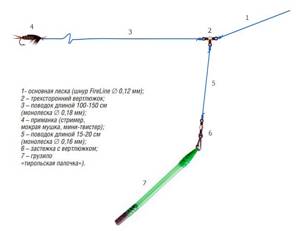
Option for setting up a Tyrolean for catching grayling, lenok, trout, minnow with flies and streamers
Each type of bait has its own effective types of animation and behavior of the fisherman in general. So, when fishing with wobblers, suspenders and ordinary edible silicone, uniform movements with pauses are used, during which the wobbler slowly shakes on its sides and gradually subsides, and the silicone fish/worm/slug/nymph slowly falls, since it is not directly loaded. Such a vertical component in the action of the bait cannot leave river pike, perch, and pike perch indifferent.
Even a passive predator, observing such lazy movements of a beaten, wounded “fry,” often cannot stand it and makes an attack.
A floating wobbler and rubber even float up when paused, gradually rising from the bottom to the height of the sum of the lengths of the leashes. If you lightly twitch the bait with the tip of the rod during a pause, this usually gives an even better effect.
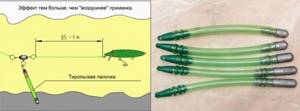
A floating wobbler is an ideal bait for the Tyrolean, the higher the buoyancy parameter, the higher the effect
If the variant of the Tyrolean stick with a final sinker is used, then it is more suitable for catching grayling, asp, char, trout, lenok, leopard, omul, chub, ide with jigs, wet flies, streamers, and small imitations of insects. If the leash is quite long, then fishing is effective even in half-water, and not just at the bottom.
You can successfully fish against the current with the Tyrolean. In this case, after casting, the cord is pulled out by pulling with pauses, giving slack from time to time, at which all the equipment is pulled in the opposite direction relative to the load. Often the bite follows precisely during pauses.
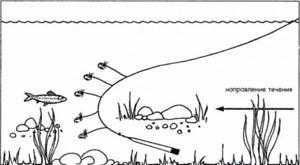
Fishing for grayling on the river - the fishing line with flies is blown out by the current, and when the fishing line is paused, the weight drags behind it, therefore, the first thing the bait predator sees
When fishing across the current, the classic fishing of a sector of 10-15 degrees is used, with the difference that, unlike a jig, in this case it is not worth fishing with a step. The best option is dragging along the bottom with some pauses, during which the baits go downstream where the Tyrolean is located.
Catching grayling with a Tyrolean stick - video from an expert:
When using heavier lures on the Tyrolean in such equipment, you can successfully catch pike, perch, and pike perch. Dragging the load near the bottom with pauses, a typical step, but with longer pauses, explosions from the bottom, twitching.
Another working setup for mini-tyrole grayling:
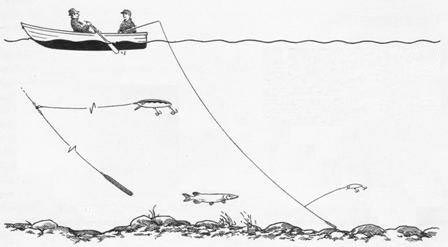
Important! When fishing with flies, streamers, nymphs, and regardless of the type of rig used, the load should always go along the bottom, periodically touching it, this ensures high-quality play between flies and streamers. The advantage of this approach is that the load creates a cloud of turbidity, and this is another factor that attracts the predator.
Useful tips
Grayling behavior is predictable. These shy fish are cautious and attentive. When they feel or notice a person, the whole flock scatters and does not return. Extreme caution is required from the catcher. We will also learn about the nuances of catching grayling at different times of the year.
Summer . A good bite in the hot season is observed in the evening or early morning. During the day, graylings are lazy and reluctant to take bait. But with the exception of cloudy weather, when the breeze creates ripples on the surface of the water. At such times, the grayling loses its vigilance and pecks recklessly. Summer bait - caddisfly butterflies (shitika) and various small insects.
Spring . When fishing in spring, it is better to use live and moving worms for bait. In spring, graylings are divided into groups, with large fish preferring to stay away from their small counterparts.
Autumn . On the eve of winter, grayling becomes bold and voracious.
Therefore, autumn fishing is considered the best time.
During this period, predators respond to both the live worm and the minnow. They go on a sortie at dusk or around noon.
Fishing ends with the arrival of freeze-up.
Winter . It is possible to prolong the pleasure and catch grayling even in frosty weather. The fish do not stop feeding during the winter months. But the beginning of trout spawning is taken into account - during this period, grayling does not take bait, feeding on trout eggs. It is better to catch grayling from the ice using jigs or spinners, and fish in a strong current.
The jumper is an invention for catching grayling at any time of the year. The Tyrolean region has been explored by millions of Russian fishermen. Having fished in wild, sometimes inaccessible places, shown a creative approach to business, and mastered various types of liners, catching grayling with a Tyrolean stick turns into a memorable vacation.
How to assemble tackle
The form for fishing with Tyrolean sticks must be clear, fast and rigid, clearly transmitting all movements of the load along the bottom into the angler’s hand. But the length of the rod depends on the length of the leash with bait used, and often this factor becomes a hindrance for an angler with a short spinning rod.
After all, the overhang of the line in this type of fishing is quite significant and a quality cast cannot be made with a short stick. Therefore, for targeted fishing with a Tyrolean stick, we can recommend a rod at least 2.7 meters long. Ideally, 3+ meters. But this is the case if at least several such fishing trips are planned, since for other fishing methods of this length a spinning rod is not needed.
You can choose a relatively inexpensive telescopic spinning rod that is loud enough to drive weights of 10-30 grams, so as not to spend unnecessarily on expensive poles for one equipment.
The spinning test is selected based on the weight of the expected sinkers with some margin at the upper limit. For small rivers, up to 20 grams is enough, but for large rivers and reservoirs, sometimes 60-70 grams will be needed.
A reel with high-quality line laying, easy movement and no loop reset. According to Shimano 2500-3000 depending on the diameter of the braid used.
The basis is either a braid with a diameter of 0.12-0.15 or a fluorine with a diameter of 0.22-0.35. Fluor leashes 0.22-0.28. When catching large pike perch and pike, the whole tackle is generally more powerful.
When used skillfully, the Tyrolean rod expands the range of capabilities of the spinning player. When fishing with a Tyrolean stick, the most difficult thing is to bring all the unknowns into one clear orchestra, clearly hammering out a march. Select the weight, length and diameter of the tyrolean, select the thickness of the fluorocarbon/braid and the length of the leashes for specific conditions so that the equipment works clearly and exactly in the direction that the spinning player and predator desire.
How to make a Tyrolean stick with your own hands?
Making tyroli yourself will not steal much of your time. For this we need:
- A hollow plastic tube, twenty centimeters long
- Weight, to fit the hole in the tube. A bolt or lead can serve as a weight
- Waterproof glue
- Swivel with latch
Progress:
- Firmly glue the weight to the first side of the tube
- Heat the end of the second side until soft, and then compress it with pliers
- We make a hole on the second side and insert a swivel
All! That's it, the tackle is ready!
What is this gear?
The Tyrolean stick consists of:
- An oblong sinker.
- Hollow plastic tube.
- Rings for fastening fishing line.
The sinker is tightly secured in a plastic tube, and at the other end it is securely sealed. Thus, in water such a device becomes in a vertical position. The fishing line is attached to the top of the Tyrolean stick using a small ring.
When fishing, the bait is always slightly raised above the bottom, which allows the fish to freely take the bait.
Fishing Features
There is one very unpleasant feature of fishing with a Tyrolean stick: no matter what type of installation, no matter what type of equipment is made, with fast wiring its advantages instantly disappear. The fact is that the fish begin to fuss and be afraid of the stick and stop swimming towards it, so the fishing begins to fade away.
For those who don’t know, retrieving is dragging the tip of a rod with bait along the bottom; it is done slowly, carefully and slowly so as not to spook the fish.
Advantages and disadvantages
Speaking about the advantages of fishing specifically with a Tyrolean stick, one important advantage should be noted - it simulates the movement of fish. When the bait is placed on the hook, thanks to the stick, it can be controlled as if it were a fish. The movements are smooth, and it does not crawl along the bottom, but maneuvers through the water.
Also, the advantages of its use include:
How to catch more fish?
I have been active fishing for quite some time and have found many ways to improve the bite. And here are the most effective:
- Bite activator. Attracts fish in cold and warm water with the help of pheromones included in the composition and stimulates its appetite. It’s a pity that Rosprirodnadzor wants to impose a ban on its sale.
- More sensitive gear. Reviews and instructions for other types of gear can be found on the pages of my website.
- Lures using pheromones.
You can get the rest of the secrets of successful fishing for free by reading our other articles on the site.
- light weight, which makes it possible to cast a fishing rod far beyond the shore, even if you use a very light wobbler;
- low probability of snags when providing wiring;
- absence of tangling, as well as the presence of overlaps, which greatly simplifies the fishing process.
There are very few disadvantages, among them:
- limited in size, since it is not always possible to make a Tyrolean stick of the size required;
- unmasking, it is too visible in reservoirs, and the fish, seeing it, do not always bite the bait, but rather get scared.
Bait
Before you go fishing, the question always arises: what kind of bait is best to take? You should not always rely only on worms; you should also not forget that each fish requires a special approach.
Here are the most popular types of baits and a list of fish that prefer them:
- worms;
This is the most popular type of bait. Probably because they are easy to get both yourself and in the store, and many fish easily bite on them. They are a kind of universal bait.
Fish that prefer worms include mainly carp species (roach, bream, bream, crucian carp, tench), as well as catfish and eel.
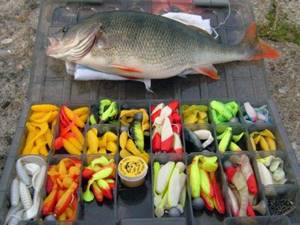
maggot;
This is not the most pleasant profit, but one of its main advantages is that it is absolutely unpretentious in storage conditions.
Fish that prefer maggots are roach, bream, bream and crucian carp.
- dragonfly larvae;
Few people know that dragonfly larvae play an important role in the biofauna of water bodies, and that they are very significant in the diet of fish.
They are preferred by roaches, as well as the entire cyprinid family.
- bread;
The accessibility and simplicity of this bait is extremely popular among novice fishermen.
White fish, crucian carp and roach prefer bread.
- crayfish;
Crayfish meat is loved by many fish that live at great depths, these include: catfish, ide, chub.
- hemp seeds.
Despite their rare use, hemp seeds can be called the best bait for roaches. The similarity to the zebra mussel shell, which this fish loves, and the smell of hemp oil make this bait very effective.
Modern sinker for bottom fishing on the river - “Tyrolean stick” (Tirolean)
This, at first glance, unusual in shape component of bottom tackle for fishing for many species of predatory and peaceful Volga fish, including pike, perch, catfish, carp and bream, which received its name from its place of origin - the city of Tyrol in Switzerland, is a sinker with special properties. The Tyrolean stick turns out to be indispensable in many cases. It works great when fishing on heavily silted, soft or overgrown bottoms, when fishing from the bottom among large stones, and also in cases where it is necessary to maintain a leash with bait just above the surface of the bottom. Considering that the riverbeds and channels of the Lower Volga, including Akhtuba and Mangut, have a fairly large number of quiet backwaters with aquatic vegetation at the bottom, this design of the sinker works effectively, which allows you to avoid unnecessary hooks and keep the bait on a certain horizon.
The “Tyrolean stick” is used on Akhtuba when catching predatory and peaceful fish as the main sinker of bottom tackle and when fishing with spinning tackle with a retractable leash. Recently, such tackle has become increasingly popular, as it allows you to fish areas of the water area that are inaccessible when using conventional sinkers. It is these areas that, as a rule, are the most catchable due to the presence of a large number of predatory and peaceful fish that gravitate towards natural obstacles on the bottom and algae.
This sinker works very effectively as an end (blind) weight paired with artificial baits on a retractable leash higher along the main line. This tackle allows you to send a very light bait over a fairly long distance without the risk of breaks due to snags on obstacles on the bottom, as well as when fishing in a strong current, which is typical for Akhtuba, when you need to constantly keep a light bait near the bottom.
Another advantage of the Tyrolean when moving along the bottom is that the sinker moving in steps taps the bottom and raises clouds of turbidity, attracting many small fish and, accordingly, an active predator.
Equipment with a Tyrolean stick for fishing on Akhtuba and Mangut
At its core, the “Tyrolean stick” sinker is a structure combined of two parts: a weight and a float. As a result, it turns out that the heavy part lies on the bottom, and the upper floating one stands up, raising the leash or main line above the bottom surface by 10-25 cm. The upper part of the Tirolka is usually a transparent plastic tube with a cross-section of 4-8 mm and a length of up to 25 cm , sometimes more. The upper end of the float tube is closed with a plug with a loop for a blind or sliding fastening for the main fishing line. A weight in the shape of a drop, a bullet or an olive is attached with glue or tension to the lower end of this tube. In any situation, this design tries to take a vertical position on the bottom, with the buoyant part up, ensuring that the fishing line is held at some distance above the bottom.
When fishing for predators on Akhtuba with a retractable leash, the Tirolka allows you to avoid or minimize accidental snags of the sinker on stones and snags, and when fishing for catfish and carp on the bottom, it reduces the risk of losing gear in the thickets and holds the bait above the level of the silted or overgrown bottom.
Placing a tackle with a Tyrolean when catching a predator on Akhtuba into the outlet
This method of catching predatory fish on Akhtuba is quite successful when using the type of sinker described above. The Tyrolean stick allows you to keep the artificial bait on the horizon, which is attractive to the predator, despite the obstacles that abound in the riverbeds of the Three Rivers.
In some situations, when it is necessary to quickly change the carrying capacity of the Tyrolean, you can put a piece of foam on the tube. After this, such a sinker will become even easier to pass obstacles on the bottom when dragged without hooks.
Most often, predators, pike perch and pike, attack the bait on tackle with a retractable leash during pauses, when the sinker freezes at the bottom.
It is best to carry the tackle with a Tyrolean stick against the current, while it is possible to either pull the tackle against the current after casting or release the line downstream with stops. Pauses should be long enough, up to 10-20 seconds. It is at these moments that the bite most often occurs.
You can, of course, do wiring across the current if there is no other possibility in this section of the riverbed. It happens that this method of fishing brings good results, especially if there are several transverse deep-sea edges or snags. Only in this case, given that the current carries the sinker to the side, you should not allow slack on the main line and make short pauses, with quick reeling.
Methods for installing equipment using a Tyrolean stick
Like any other bottom sinker, the tyrole as part of the rig can be used as an end sinker at the end of the main line with leads above or as a sliding weight in front of the leads.
If the tyrolean is fixed tightly at the end, then one or two leashes with bait are attached higher on the main line (and it can be different, so
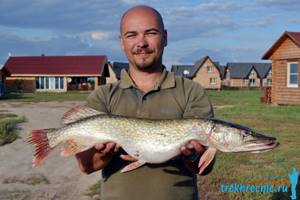
increases the catchability of the tackle), the length of which is approximately equal to the length of the stick itself - this allows you to avoid snags. The bait or bait on the hooks in such gear should be light enough so as not to affect the game of the Tyrolean itself. Almost all baits of animal origin are used: worms, maggots, pieces of fresh fish, etc., and small silicone (twisters and vibrotails), streamers, fly fishing flies and small spoons or wobblers can be used as artificial baits.
In the case when the Tyrolean stick is mounted before the leash, one leash is used, which can be up to 1 m long and have at the end all of the above lures or baits. Sometimes in such gear they place another short leash above the sinker; this design is prone to tangling when casting and is usually used in cases where the gear can be cast along a clean bottom.
When fishing with a pull-out leash, the weight of the Tyrolean stick, depending on the weight of the bait, the current and the depths from which fishing is carried out, is selected in the range of 15-30 grams. It is better to make a leash from a rigid, high-strength monofilament line, for example, fluorocarbon or even a thin steel cord - such a leash better holds the bait on a given horizon and is less prone to overlap when casting.
After casting, we let the bait with the sinker fall to the bottom, straighten out in the current, and then, constantly monitoring the tension of the fishing line, we begin reeling: 2-3 quick turns - a pause of 15-20 seconds - reeling again. Sometimes, if the predator’s bite is sluggish, the following action brings good results: during pauses, make several short twitches with the tip of the rod - the bait plays more actively at this moment, which can provoke a pike perch or pike to attack.
During such wiring, you need to ensure that the fishing line does not sag, and that the spinning rod is directed upward at an oblique angle, since in this case the end of the rod is a bite indicator. At the slightest hint of a bite, you should strike with a sharp stroke of the brush. This is due to the fact that an obtuse angle appears between the bait and the main line in the current, that is, there is extra line, which should be selected due to the large hooking amplitude.
Tyrolean stick for fishing for catfish on Akhtuba
Catching catfish on Akhtuba is a very popular and serious activity, given that there are a lot of catfish in these places and the weight of caught specimens often reaches 40, 60 and even 100 kg. As a rule, catfish here are caught with bottom tackle from the shore or with a quok from a boat. When installing equipment for bottom fishing for catfish, taking into account strong currents and great depths, rather massive sinkers are used. A heavy Tyrolean stick turns out to be indispensable in such a situation. On Akhtuba, for such fishing they use tyroles weighing from 150 to 250 grams, otherwise the tackle will simply be carried away by the current, namely the position of the tackle in a certain place, near the catfish’s bedding area, all the time fishing is the key to successful fishing. To avoid losing all the gear when drifting into a snag or landing a large catfish, which tends to go into thickets of vegetation and under flooded trees, the tirol is made with a fastening that is detachable from the fishing line. This is achieved by using special snap hooks or inserting the top plug into the float tube with a line mount without glue, pulling it in so that it can come out when the sinker jams.
Another very important advantage of the Tyrolean stick is the ability to easily make it yourself.
Making a Tyrolean stick with your own hands
To make a Tyrolean yourself, you will need the following materials: - a piece of PVC tube with a cross section of 5-8 mm with thin walls; - pieces of lead or brass bolts (they are heavier than steel); - waterproof glue, carabiner with swivel, etc. At the bottom of the tube we screw in a bolt (you can adjust the weight by selecting different bolts and adding lead. On the other side of the tube we insert, with or without glue, a plug with a ring for attaching the swivel. You can also simply flatten the top part of the tube, smear it with glue inside and make a small hole for the winding ring. The main thing is that the Tyrolean should confidently stay on the bottom in a vertical position and not let out bubbles. That's it, ready.
Happy fishing!
More
